I've recently added some features to Things Have Changed to make it easier to navigate and find stuff.
On the left-side there are two new features at the top:
The first is Critical Info which contains key posts about the blog, including this one.
Below it is Posts By Category. If you are interested in finding all posts on a specific topic, or a post which you can't otherwise find but know the subject matter you can click on the relevant category. About 95% of the posts to date are labeled in one or more of the listed categories.
The right-side also has two new features located about halfway down the column:
The first is Some Of My Favorite Posts which links a number of posts, mostly from the first months of the blog, that I particularly like.
The second is Most Popular Posts, showing the five posts with the most pageviews. One-Hit Wonders (1964-68) is by far the most popular post. I'll occasionally update this section.
Also, below is the text of the May 3 post with additional navigation information.
Had questions from some folks who don't read many blogs. Key things to know:
The blog looks different depending on whether you are viewing it on a PC/Tablet or a Mobile Device.
Tuesday, October 30, 2012
Monday, October 29, 2012
SandyCam
For all Hurricane Sandy followers here's the view from the Statue Of Liberty Webcam. You'll be able to watch and listen as the storm surge hits Manhattan, if that's your thing.
UPDATE: You may have difficulty accessing the website due to heavy demand.
UPDATE: You may have difficulty accessing the website due to heavy demand.
Monday Morning Word Up Call
"If there's music we can use it, we need to danceIt hit #6 on the Billboard singles chart in 1986. Word Up was the first Top 40 hit for Cameo. Added bonus is the sampling of Enni Morricone's theme from The Good, The Bad and The Ugly. Oh, and you've got Levar Burton playing the detective in the video. Good hair.
We don't have no time for psychological romance"
And props to lead singer Larry Blackmon for bringing back the codpiece as a fashion statement!
Sunday, October 28, 2012
'Scuse Me While I Disappear
I wrote about my favorite Sinatra song in an earlier post but at that time only had a live version to insert. I've now found a video version of the studio recording of Angel Eyes featuring a masterful arrangement by Nelson Riddle. Sinatra's vocal is impeccable from start to finish and the instrumentation adds so much more than in the live version. You should listen and savor it to the very last note.Written by Matt Dennis and Earl Brent.
Saturday, October 27, 2012
Elvis May Be Leaving The Building
There is mounting evidence that Voyager 1 (launched in 1977) may have become the first spacecraft to exit the Solar System.
While NASA has not yet officially declared that the spacecraft has passed the threshold the linked article cites the data indicating the three criteria that must be met have either happened or are on the verge of occurring.
1. An increase in high-energy cosmic rays originating from outside our solar system
2. A drop in charged particles emanating from the sun.
3. A change in the direction of the magnetic field.
From NASA's Jet Propulsion Laboratory:

While NASA has not yet officially declared that the spacecraft has passed the threshold the linked article cites the data indicating the three criteria that must be met have either happened or are on the verge of occurring.
1. An increase in high-energy cosmic rays originating from outside our solar system
2. A drop in charged particles emanating from the sun.
3. A change in the direction of the magnetic field.
From NASA's Jet Propulsion Laboratory:
Friday, October 26, 2012
OK Corralapalooza
At about 3pm on a sunny afternoon on this date in 1881, Wyatt, Virgil and Morgan Earp along with their friend Doc Holliday left Hafford's Saloon in Tombstone, Arizona (one of 110 saloons in a town of 7,000) on a walk that would take them to the vacant lot next to C.S. Fly's Photography Studio, a lot that served as the back entrance to the O.K. Corral.
Thirty seconds and thirty gunshots in that vacant lot gave birth to the legend of Wyatt Earp, hundreds of books, a TV series and decades of movies culminating in the shoot out between Kurt Russell's Tombstone (released December 1993) and Kevin Costner's Wyatt Earp (released in June 1994). Wyatt's time in Tombstone also bestowed on us many of the names plastered repeatedly on characters in Western films and books since the 1920s - Doc Holliday, Johnny Ringo, Curly Bill, Ike Clanton, Frank Stilwell, Pete Spence,
time in Tombstone also bestowed on us many of the names plastered repeatedly on characters in Western films and books since the 1920s - Doc Holliday, Johnny Ringo, Curly Bill, Ike Clanton, Frank Stilwell, Pete Spence,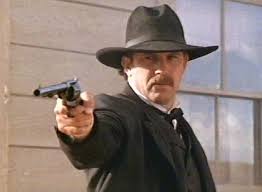 Indian Charlie and Big Nose Kate Elder (the inspiration for the 1965 John Wayne film, The Sons Of Katie Elder).
Indian Charlie and Big Nose Kate Elder (the inspiration for the 1965 John Wayne film, The Sons Of Katie Elder).
The big question for all Earp aficionados is which do you prefer: Wyatt Earp or Tombstone? Wyatt Earp is a Kevin Costner film which means it is bombastic, long (you could cut the first 30 or 40 minutes and not lose much) and works too hard to achieve mythic status. Even with this, it is still a fine movie but Costner was just warming up in this regard as he soon moved on to Waterworld (1995) - ridiculous - and The Postman (1997) - horrible. Wyatt Earp also has superb cinematography which gives it an iconic look. The Kurt Russell film is more workmanlike in its look but well-cast and more focused. Wyatt Earp is about the life and legend of Wyatt. Tombstone is a rousing Western about a big gunfight and its immediate aftermath. Both have their strong points and both are surprisingly accurate by the usual standards of Hollywood, though I would have to give the nod on a close call to Wyatt Earp (later we'll touch on some of the bigger inaccuracies in Tombstone which occur during The Vendetta Ride segment). And any story that had a real episode called "The Vendetta Ride" has to be pretty good.
Here's some of the essential facts (and we'll stick to the essentials as the details could fill a book - indeed, they've filled many books and the authors still argue about every detail - my favorite is Wyatt Earp: The Life Behind The Legend (1999) by Casey Tefertiller). We'll look at the background, some pictures and movie clips and even have a singalong towards the end:
The lead up to the gunfight in both movies is well done. The conflict between the Earps and the Cowboys is well-portrayed as is the confusing jurisdictional law enforcement morass - US Marshals, the Cochise County Sheriff and the Town of Tombstone Marshal. Even the scene when Wyatt protects Curly Bill Brocius from a mob after he accidentally shoots and kills Town Marshall Fred White is accurate.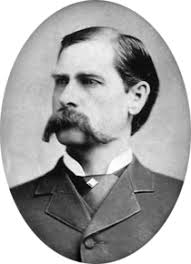 (Wyatt Earp during the Tombstone years)
(Wyatt Earp during the Tombstone years)
Was the supply of Earp brothers endless?
Almost, but not quite. Wyatt had five brothers, Virgil, Morgan, James, Warren and Newton, all of whom, with the exception of Newton, showed up in Tombstone at one time or another. Both movies accurately portray the intensity of the family bond among the brothers.
Was the Tombstone newspaper the Nugget or the Epitaph?
Both. Tombstone supported two papers. The Epitaph and its editor, John Clum, backed Earp who were Republicans just like the paper. The Nugget backed the Cowboys and County Sheriff Johnny Behan, who were Democrats. Yes, there were also politics involved. The Cowboys were mostly transplanted Southerners and Democrats while the Earps were Missouri Republicans who'd been loyal to the Union during the Civil War.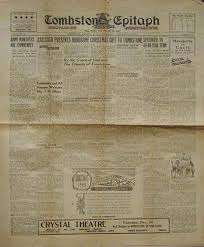 After Wyatt fled Arizona, politics was to play a role in saving him from prosecution.
After Wyatt fled Arizona, politics was to play a role in saving him from prosecution.
Why did the gunfight at the OK Corral become famous?
True face to face gunfights (like in High Noon) were a rarity in the West. Most of the famous shoot outs were really ambushes or drunken brawls in saloons. The OK Corral gunfight was not only face to face but there were multiple participants on each side. When the Earps and Holliday entered the vacant lot they found five men facing them only about eight to ten feet away - Ike and Billy Clanton, Tom and Frank McLaury and Billy Claiborne. After a couple of moments, Billy Claiborne fled through the back of the lot. Ike Clanton did not have a gun (as strange as it seems, the scene in both movies when Ike approaches Wyatt in the middle of the gunfight to yell he's unarmed really happened). (Ike Clanton)
(Ike Clanton)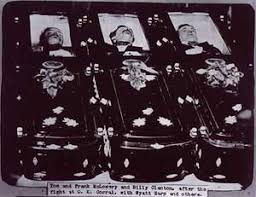 (The McLaurys & Billy Clanton)
(The McLaurys & Billy Clanton)
So, it was four guns against three when it started. No one can say definitively who fired first, though the majority of witnesses said it was one of the McLaurys. What all said was that there were initially two shots, a halt and then the barrage started. When it was over both the McLaurys and Billy Clanton were dead and Virgil and Morgan Earp as well as Doc Holliday were wounded. Wyatt was the only man in the fight not to be hit by a bullet. It made newspapers across the country.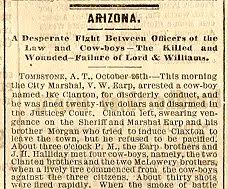
And finally, what you've all been waiting for: a side by side comparison of how both movies handle the gunfight!
What happened after the gunfight?
The scene in both movies when Sheriff Behan tries to arrest the Earps right after the gunfight and Wyatt angrily refuses is accurate. However, within days Ike Clanton filed a complaint seeking murder charges against the Earps and Holiday and they were arrested and forced to post bail. Within a week Justice of the Peace Wells Spicer convened a formal hearing to determine whether they should be charged. It lasted almost a month at the end of which Spicer, while not condoning the lawmen's actions, decided that murder charges were unjustified. Spicer wrote of Virgil Earp in terms reflecting the reality of life in a Western boomtown:
The Cowboys were incensed by the ruling and tensions increased even further between them and the Earps. Then, on the evening of December 28, Virgil was ambushed as he patrolled the streets of Tombstone. Although he survived, the wounds cost him the use of his right arm for the rest of his life.
After Virgil's shooting the situation continued to deteriorate and the Earps became even more concerned about their safety staying most of the time in their homes with their families. On March 18, 1882, Wyatt and Morgan decided to take a chance and went to play billiards at a saloon. Shots came from outside and Morgan was hit in the back and died while another bullet just missed Wyatt's head. Both incidents are portrayed accurately in the movies, though Tombstone telescopes them into the same night.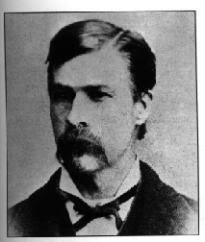 (Morgan)
(Morgan)
Wyatt believed he knew who was behind both attacks but was unable to persuade law enforcement to take action. Despairing of his chances to get justice through the legal process and worried about the safety of his family, Wyatt arranged to evacuate the extended Earp clan to California and the day after Morgan's death they set off to try to get to the train in Tucson.
Did Wyatt really pump lead into Frank Stilwell at the Tucson rail yard?
By all accounts, yes. And by most accounts even after Stilwell tried to surrender. The attempted ambush of the Earp family by Ike Clanton, Stilwell and others at the rail yard was the final straw for Wyatt. From the killing of Stillwell on March 20 until he left the Arizona Territory on about April 15, Wyatt engaged in what became known in the press as The Vendetta Ride. (Stilwell)
(Stilwell)
The Vendetta Ride attracted even more national notoriety than the OK Corral. Wyatt, riding with Doc Holliday, Turkey Creek Johnson, Texas Jack Vermillion, Hairlip Charlie Smith (gosh, it's fun to type those nicknames!) and Sherm McMasters, set out after the men he believed killed Morgan and wounded Virgil.
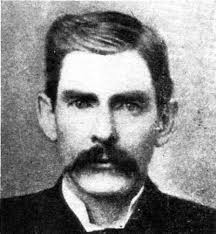 (Doc Holliday)
(Doc Holliday)
Just before they left Tucson, County Sheriff Behan learned that arrest warrants had been issued for Wyatt and his posse. He attempted to arrest him once again and, as you see in at least one of the movies, Wyatt really did say:
Behan backed off and Wyatt's posse left town. At that point, Wyatt was still a Deputy US Marshal and he had deputized his companions but he was acting completely outside of his legal authority - this was a vigilante ride. Behan put together his own posse to track down Wyatt. You can see why the newspapers loved this story. You have a Deputy US Marshal, putting together an illegal posse to avenge his brother's death, being chased by another lawman's posse which is acting in cahoots with the outlaws whom the Deputy Marshal is tracking.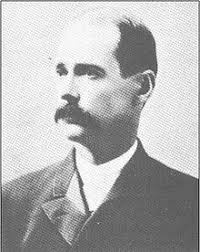 (Johnny Behan)
(Johnny Behan)
Here's where Tombstone goes a little offtrack. The Earp posse is shown shooting a whole bunch of cowboys along with Wyatt gunning down Curly Bill Brocius in the middle of a creek and Doc (disguised as Wyatt) killing Johnny Ringo. In truth, besides Frank Stilwell, there are only three other cowboys definitely known to have been killed by the Earp posse - Indian Charlie Cruz (who took part in the shooting of Virgil), Curly Bill and Johnny Barnes. The portrayal of Wyatt's gunfight with Curly Bill in Wyatt Earp is much more accurate than the Tombstone version. (Curly Bill) Wyatt's posse was ambushed and his companions either fled or were pinned down. Wyatt shot Barnes and then, while Curly's gang took shots at him, Wyatt killed Curly Bill in a shotgun duel at pointblank range. As shown in the films, Wyatt's coat was riddled with bullets but he emerged unscathed.
(Curly Bill) Wyatt's posse was ambushed and his companions either fled or were pinned down. Wyatt shot Barnes and then, while Curly's gang took shots at him, Wyatt killed Curly Bill in a shotgun duel at pointblank range. As shown in the films, Wyatt's coat was riddled with bullets but he emerged unscathed.
As far as Johnny Ringo goes, he was found dead several months after the vendetta ride, seated at the base of a tree with a bullet in his head. The rumor was that Wyatt had sneaked back into the Territory to kill him. However, most historians are convinced Ringo committed suicide and that Wyatt never returned to Arizona. Notwithstanding the facts, it gave us a memorable scene from Tombstone ("I'm your huckleberry"), which is cleverly staged so that Ringo ends up against the tree with a bullet in his head, so we'll go to the video here.
Who was the better Doc Holliday - Dennis Quaid (Wyatt Earp) or Val Kilmer (Tombstone)?
Next to which movie is better, this is what folks most like to argue about. Doc Holliday is just a great character to play. Mean, murderous, drunk and dying of tuberculosis - what more could you ask for? Dennis Quaid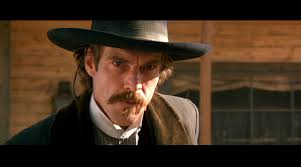 must have starved himself for a couple of months before showing up for the filming and is one truculent guy. Val Kilmer
must have starved himself for a couple of months before showing up for the filming and is one truculent guy. Val Kilmer  didn't miss many meals but may have infected himself with tuberculosis in order to nail the role. Quaid is probably closer in character to the real Doc Holliday (who really was pretty nasty to everyone except Wyatt whom he cherished as a true friend). Kilmer has more fun with the role and gives Holliday an element of charm which, by most accounts, he did not have. I'll give Kilmer the nod on this one for the sheer enjoyment of watching him.
didn't miss many meals but may have infected himself with tuberculosis in order to nail the role. Quaid is probably closer in character to the real Doc Holliday (who really was pretty nasty to everyone except Wyatt whom he cherished as a true friend). Kilmer has more fun with the role and gives Holliday an element of charm which, by most accounts, he did not have. I'll give Kilmer the nod on this one for the sheer enjoyment of watching him.
What was the worst miscasting in either film?
Easy, Dana Delaney in Tombstone as Wyatt's and Behan's love interest, Sadie Marcus. Wrong age, wrong character, wrong look. I thought the casting in Tombstone was overall stronger than in Wyatt Earp but Delaney is jarringly bad and out of place. (Sadie Marcus)
(Sadie Marcus) (Dana Delaney) The basic story is, however, true. Josephine Sarah "Sadie" Marcus, was an 18 year old touring dancer from San Francisco when she met Johnny Behan and she eventually ended up with Wyatt Earp. Though never married, Sadie and Wyatt stayed together until Wyatt's death in 1929.
(Dana Delaney) The basic story is, however, true. Josephine Sarah "Sadie" Marcus, was an 18 year old touring dancer from San Francisco when she met Johnny Behan and she eventually ended up with Wyatt Earp. Though never married, Sadie and Wyatt stayed together until Wyatt's death in 1929.
What happened after Tombstone?
Wyatt and Doc fled to Colorado where Doc entered a sanatorium for treatment of his TB, from which he died six years later. The Republican governor protected them (after meeting with Wyatt's friend, Bat Masterson) from the extradition request from Arizona and the legal threat against Wyatt ended although he never again entered Arizona.
To no one's surprise or regret, Ike Clanton was shot and killed in 1887 resisting arrest for cattle-rustling.
After wandering in Colorado and Idaho for several years, Wyatt and Sadie relocated to California where they spent most of the rest of their lives, living first in San Diego and then moving to San Francisco. Because of his reputation, Wyatt was asked to referee the Fitzsimmons-Sharkey World Heavyweight Championship boxing match which took place in San Francisco in 1896. Wyatt's inexperience contributed to making the match a debacle and raising questions about whether it was fixed. A couple of years later, he and Sadie joined the Klondike Gold Rush and went to Nome where they opened a saloon and were quite successful. Their trip to Alaska is the final scene of Wyatt Earp and the story of Johnny-Behind-The-Deuce around which that scene pivots is also true.
Returning to California they spent the next three decades working mining stakes in the desert and spending the winters living in rented apartments in Los Angeles. As Hollywood grew in those years the first silent Western movie stars such as Tom Mix and William S Hart sought Earp out for advice. The young John Wayne, just starting his career, also met Wyatt. In the 1980s, Hollywood made an oddball and funny movie about this period in Earp's life called Sunset, starring James Garner as Wyatt (and Bruce Willis as Tom Mix), who is hired by a studio to solve a murder.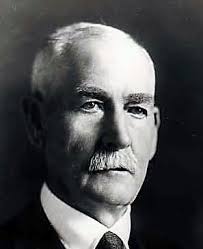 (Earp in 1928)
(Earp in 1928)
Wyatt died in 1929 at the age of 80, having survived all his brothers (Sadie was to live until 1944). Among the pallbearers at his funeral were Mix and Hart as well as John Clum, the former mayor editor of The Tombstone Epitaph. Clum survived an assassination attempt by the Cowboys after the OK Corral gunfight and had fled Tombstone because of continued threats. Clum was no coward - in 1877 he had captured Geronimo - but like the Earps, he found Tombstone too dangerous. And, in an example of how intertwined all the major players were, earlier in the same month as the OK Corral shootout, Mayor Clum led a posse including the Earp Brothers and Johnny Behan into the Dragoon Mountains in a fruitless search for an Apache band, led by Geronimo, which had broken out of the San Carlos reservation. Along the way they had a peaceful encounter with Curly Bill and others of the Clanton gang.
Clum was one of many Earp supporters who left Tombstone in early 1882. With the end of the silver boom later in the 1880s, the remaining newspapers and citizenry in the shrunken town were now almost exclusively Cowboy supporters and over the years their hostility to the Earps prompted the publication of many articles were published blackening their reputation. In the 1920s, Wyatt decided to engage a biographer to tell his side of the story and it was through these efforts, particularly the publication in 1931 of Wyatt Earp: Frontier Marshal by Stuart Lake, a highly embellished and often inaccurate account of Earp's life which nonetheless achieved great success, that the legend of Wyatt Earp was created. (Hugh O'Brien in the TV Series, Wyatt Earp)
(Hugh O'Brien in the TV Series, Wyatt Earp)
Hey, since this a Palooza themed post let's have a little Wyatt Earp singalong! Ready?
The real Wyatt Earp engaged in some unsavory behavior by our standards, involving himself in gambling and prostitution. He was also an honest lawman, until he lost his faith in the justice system leading to The Vendetta Ride, during a time in the West when the line between law and outlaw could be hard to discern. Most of all he was brave man with steady nerves in a showdown. His encounters with Curly Bill Brocius showcase this aspect of his character. Wyatt faced down the lynch mob that wanted to hang Curly Bill after he killed Wyatt's friend, Fred White, while just over a year later an outnumbered Wyatt strode into gunfire to kill Curly Bill in the shotgun duel.
Thirty seconds and thirty gunshots in that vacant lot gave birth to the legend of Wyatt Earp, hundreds of books, a TV series and decades of movies culminating in the shoot out between Kurt Russell's Tombstone (released December 1993) and Kevin Costner's Wyatt Earp (released in June 1994). Wyatt's
The big question for all Earp aficionados is which do you prefer: Wyatt Earp or Tombstone? Wyatt Earp is a Kevin Costner film which means it is bombastic, long (you could cut the first 30 or 40 minutes and not lose much) and works too hard to achieve mythic status. Even with this, it is still a fine movie but Costner was just warming up in this regard as he soon moved on to Waterworld (1995) - ridiculous - and The Postman (1997) - horrible. Wyatt Earp also has superb cinematography which gives it an iconic look. The Kurt Russell film is more workmanlike in its look but well-cast and more focused. Wyatt Earp is about the life and legend of Wyatt. Tombstone is a rousing Western about a big gunfight and its immediate aftermath. Both have their strong points and both are surprisingly accurate by the usual standards of Hollywood, though I would have to give the nod on a close call to Wyatt Earp (later we'll touch on some of the bigger inaccuracies in Tombstone which occur during The Vendetta Ride segment). And any story that had a real episode called "The Vendetta Ride" has to be pretty good.
Here's some of the essential facts (and we'll stick to the essentials as the details could fill a book - indeed, they've filled many books and the authors still argue about every detail - my favorite is Wyatt Earp: The Life Behind The Legend (1999) by Casey Tefertiller). We'll look at the background, some pictures and movie clips and even have a singalong towards the end:
The lead up to the gunfight in both movies is well done. The conflict between the Earps and the Cowboys is well-portrayed as is the confusing jurisdictional law enforcement morass - US Marshals, the Cochise County Sheriff and the Town of Tombstone Marshal. Even the scene when Wyatt protects Curly Bill Brocius from a mob after he accidentally shoots and kills Town Marshall Fred White is accurate.
Was the supply of Earp brothers endless?
Almost, but not quite. Wyatt had five brothers, Virgil, Morgan, James, Warren and Newton, all of whom, with the exception of Newton, showed up in Tombstone at one time or another. Both movies accurately portray the intensity of the family bond among the brothers.
Was the Tombstone newspaper the Nugget or the Epitaph?
Both. Tombstone supported two papers. The Epitaph and its editor, John Clum, backed Earp who were Republicans just like the paper. The Nugget backed the Cowboys and County Sheriff Johnny Behan, who were Democrats. Yes, there were also politics involved. The Cowboys were mostly transplanted Southerners and Democrats while the Earps were Missouri Republicans who'd been loyal to the Union during the Civil War.
Why did the gunfight at the OK Corral become famous?
True face to face gunfights (like in High Noon) were a rarity in the West. Most of the famous shoot outs were really ambushes or drunken brawls in saloons. The OK Corral gunfight was not only face to face but there were multiple participants on each side. When the Earps and Holliday entered the vacant lot they found five men facing them only about eight to ten feet away - Ike and Billy Clanton, Tom and Frank McLaury and Billy Claiborne. After a couple of moments, Billy Claiborne fled through the back of the lot. Ike Clanton did not have a gun (as strange as it seems, the scene in both movies when Ike approaches Wyatt in the middle of the gunfight to yell he's unarmed really happened).
So, it was four guns against three when it started. No one can say definitively who fired first, though the majority of witnesses said it was one of the McLaurys. What all said was that there were initially two shots, a halt and then the barrage started. When it was over both the McLaurys and Billy Clanton were dead and Virgil and Morgan Earp as well as Doc Holliday were wounded. Wyatt was the only man in the fight not to be hit by a bullet. It made newspapers across the country.
And finally, what you've all been waiting for: a side by side comparison of how both movies handle the gunfight!
What happened after the gunfight?
The scene in both movies when Sheriff Behan tries to arrest the Earps right after the gunfight and Wyatt angrily refuses is accurate. However, within days Ike Clanton filed a complaint seeking murder charges against the Earps and Holiday and they were arrested and forced to post bail. Within a week Justice of the Peace Wells Spicer convened a formal hearing to determine whether they should be charged. It lasted almost a month at the end of which Spicer, while not condoning the lawmen's actions, decided that murder charges were unjustified. Spicer wrote of Virgil Earp in terms reflecting the reality of life in a Western boomtown:
". . . yet we consider the conditions of affairs incident to a frontier country, the lawlessness and disregard for human life, the existence of a law-defying element in our midst, the fear and feeling of insecurity that has existed, the supposed prevalence of bad, desperate and reckless men who have been a terror to the country . . . and considering the many threats that have been made against the Earps, I can attach no criminality to his unwise act [deputizing Wyatt and Doc]. In fact, as the result plainly proves, he needed the assistance and support of staunch and true friends upon whose courage, coolness and fidelity he could depend . . . "
The Cowboys were incensed by the ruling and tensions increased even further between them and the Earps. Then, on the evening of December 28, Virgil was ambushed as he patrolled the streets of Tombstone. Although he survived, the wounds cost him the use of his right arm for the rest of his life.
After Virgil's shooting the situation continued to deteriorate and the Earps became even more concerned about their safety staying most of the time in their homes with their families. On March 18, 1882, Wyatt and Morgan decided to take a chance and went to play billiards at a saloon. Shots came from outside and Morgan was hit in the back and died while another bullet just missed Wyatt's head. Both incidents are portrayed accurately in the movies, though Tombstone telescopes them into the same night.
Wyatt believed he knew who was behind both attacks but was unable to persuade law enforcement to take action. Despairing of his chances to get justice through the legal process and worried about the safety of his family, Wyatt arranged to evacuate the extended Earp clan to California and the day after Morgan's death they set off to try to get to the train in Tucson.
Did Wyatt really pump lead into Frank Stilwell at the Tucson rail yard?
By all accounts, yes. And by most accounts even after Stilwell tried to surrender. The attempted ambush of the Earp family by Ike Clanton, Stilwell and others at the rail yard was the final straw for Wyatt. From the killing of Stillwell on March 20 until he left the Arizona Territory on about April 15, Wyatt engaged in what became known in the press as The Vendetta Ride.
The Vendetta Ride attracted even more national notoriety than the OK Corral. Wyatt, riding with Doc Holliday, Turkey Creek Johnson, Texas Jack Vermillion, Hairlip Charlie Smith (gosh, it's fun to type those nicknames!) and Sherm McMasters, set out after the men he believed killed Morgan and wounded Virgil.
Just before they left Tucson, County Sheriff Behan learned that arrest warrants had been issued for Wyatt and his posse. He attempted to arrest him once again and, as you see in at least one of the movies, Wyatt really did say:
"Johnny, if you're not careful you'll see me once too often"
Behan backed off and Wyatt's posse left town. At that point, Wyatt was still a Deputy US Marshal and he had deputized his companions but he was acting completely outside of his legal authority - this was a vigilante ride. Behan put together his own posse to track down Wyatt. You can see why the newspapers loved this story. You have a Deputy US Marshal, putting together an illegal posse to avenge his brother's death, being chased by another lawman's posse which is acting in cahoots with the outlaws whom the Deputy Marshal is tracking.
Here's where Tombstone goes a little offtrack. The Earp posse is shown shooting a whole bunch of cowboys along with Wyatt gunning down Curly Bill Brocius in the middle of a creek and Doc (disguised as Wyatt) killing Johnny Ringo. In truth, besides Frank Stilwell, there are only three other cowboys definitely known to have been killed by the Earp posse - Indian Charlie Cruz (who took part in the shooting of Virgil), Curly Bill and Johnny Barnes. The portrayal of Wyatt's gunfight with Curly Bill in Wyatt Earp is much more accurate than the Tombstone version.
As far as Johnny Ringo goes, he was found dead several months after the vendetta ride, seated at the base of a tree with a bullet in his head. The rumor was that Wyatt had sneaked back into the Territory to kill him. However, most historians are convinced Ringo committed suicide and that Wyatt never returned to Arizona. Notwithstanding the facts, it gave us a memorable scene from Tombstone ("I'm your huckleberry"), which is cleverly staged so that Ringo ends up against the tree with a bullet in his head, so we'll go to the video here.
Who was the better Doc Holliday - Dennis Quaid (Wyatt Earp) or Val Kilmer (Tombstone)?
Next to which movie is better, this is what folks most like to argue about. Doc Holliday is just a great character to play. Mean, murderous, drunk and dying of tuberculosis - what more could you ask for? Dennis Quaid
What was the worst miscasting in either film?
Easy, Dana Delaney in Tombstone as Wyatt's and Behan's love interest, Sadie Marcus. Wrong age, wrong character, wrong look. I thought the casting in Tombstone was overall stronger than in Wyatt Earp but Delaney is jarringly bad and out of place.
What happened after Tombstone?
Wyatt and Doc fled to Colorado where Doc entered a sanatorium for treatment of his TB, from which he died six years later. The Republican governor protected them (after meeting with Wyatt's friend, Bat Masterson) from the extradition request from Arizona and the legal threat against Wyatt ended although he never again entered Arizona.
To no one's surprise or regret, Ike Clanton was shot and killed in 1887 resisting arrest for cattle-rustling.
After wandering in Colorado and Idaho for several years, Wyatt and Sadie relocated to California where they spent most of the rest of their lives, living first in San Diego and then moving to San Francisco. Because of his reputation, Wyatt was asked to referee the Fitzsimmons-Sharkey World Heavyweight Championship boxing match which took place in San Francisco in 1896. Wyatt's inexperience contributed to making the match a debacle and raising questions about whether it was fixed. A couple of years later, he and Sadie joined the Klondike Gold Rush and went to Nome where they opened a saloon and were quite successful. Their trip to Alaska is the final scene of Wyatt Earp and the story of Johnny-Behind-The-Deuce around which that scene pivots is also true.
Returning to California they spent the next three decades working mining stakes in the desert and spending the winters living in rented apartments in Los Angeles. As Hollywood grew in those years the first silent Western movie stars such as Tom Mix and William S Hart sought Earp out for advice. The young John Wayne, just starting his career, also met Wyatt. In the 1980s, Hollywood made an oddball and funny movie about this period in Earp's life called Sunset, starring James Garner as Wyatt (and Bruce Willis as Tom Mix), who is hired by a studio to solve a murder.
Wyatt died in 1929 at the age of 80, having survived all his brothers (Sadie was to live until 1944). Among the pallbearers at his funeral were Mix and Hart as well as John Clum, the former mayor editor of The Tombstone Epitaph. Clum survived an assassination attempt by the Cowboys after the OK Corral gunfight and had fled Tombstone because of continued threats. Clum was no coward - in 1877 he had captured Geronimo - but like the Earps, he found Tombstone too dangerous. And, in an example of how intertwined all the major players were, earlier in the same month as the OK Corral shootout, Mayor Clum led a posse including the Earp Brothers and Johnny Behan into the Dragoon Mountains in a fruitless search for an Apache band, led by Geronimo, which had broken out of the San Carlos reservation. Along the way they had a peaceful encounter with Curly Bill and others of the Clanton gang.
Clum was one of many Earp supporters who left Tombstone in early 1882. With the end of the silver boom later in the 1880s, the remaining newspapers and citizenry in the shrunken town were now almost exclusively Cowboy supporters and over the years their hostility to the Earps prompted the publication of many articles were published blackening their reputation. In the 1920s, Wyatt decided to engage a biographer to tell his side of the story and it was through these efforts, particularly the publication in 1931 of Wyatt Earp: Frontier Marshal by Stuart Lake, a highly embellished and often inaccurate account of Earp's life which nonetheless achieved great success, that the legend of Wyatt Earp was created.
Hey, since this a Palooza themed post let's have a little Wyatt Earp singalong! Ready?
The real Wyatt Earp engaged in some unsavory behavior by our standards, involving himself in gambling and prostitution. He was also an honest lawman, until he lost his faith in the justice system leading to The Vendetta Ride, during a time in the West when the line between law and outlaw could be hard to discern. Most of all he was brave man with steady nerves in a showdown. His encounters with Curly Bill Brocius showcase this aspect of his character. Wyatt faced down the lynch mob that wanted to hang Curly Bill after he killed Wyatt's friend, Fred White, while just over a year later an outnumbered Wyatt strode into gunfire to kill Curly Bill in the shotgun duel.
Thursday, October 25, 2012
Talking Back To TED
The first few times I saw TED Talks I was impressed. Then you start to notice a certain sameness to the format and the attitudes of the speakers. This pseudo-TED Talk from The Onion (which previously gave us the shocking Truth About Facebook) on Compost-Fueled Cars perfectly captures the ethos of TED.
Wednesday, October 24, 2012
Ravello
We already did one post on our visits to the Amalfi Coast (see Praiano) in 2006 and 2010 and we'll probably return there next year.
This is Ravello, another one of the towns we've visited. Unlike most of the other towns which are located right on the coast, Ravello is on top of a small mountain making it a torturous drive to get there. This map shows the convoluted road network. That's why the second time we visited we stayed in Ravello instead of making the daily drive even though it was only about 10 miles from the hotel we like so much in Praiano. (Looking from Ravello down to the coast. From Google Images. Rest of pictures are from our trips.)
(Looking from Ravello down to the coast. From Google Images. Rest of pictures are from our trips.)
Your first assignment is getting to Ravello which can be a challenge. Here's a tip - fold in your side view mirrors. These photos are of the main road - not a side street. I just thought of another tip - make sure you get damage coverage on your rental car - take my word on this one.

The neighboring hill town as seen from the plaza.
No motor vehicles are allowed in the center of town so you can walk undisturbed on the paths, stairs and alleys (there are no roads).



We stayed at the Hotel Graal.

Our terrace.
We've haven't even gotten to the best part of the town yet - the villas - which we'll cover in a separate post. Let's start walking towards the Villa Cimbrone and stop at a little cafe for a drink first.
This is Ravello, another one of the towns we've visited. Unlike most of the other towns which are located right on the coast, Ravello is on top of a small mountain making it a torturous drive to get there. This map shows the convoluted road network. That's why the second time we visited we stayed in Ravello instead of making the daily drive even though it was only about 10 miles from the hotel we like so much in Praiano.
Your first assignment is getting to Ravello which can be a challenge. Here's a tip - fold in your side view mirrors. These photos are of the main road - not a side street. I just thought of another tip - make sure you get damage coverage on your rental car - take my word on this one.

The neighboring hill town as seen from the plaza.
No motor vehicles are allowed in the center of town so you can walk undisturbed on the paths, stairs and alleys (there are no roads).



We stayed at the Hotel Graal.
Working hard at Ravello restaurants.

Our terrace.
We've haven't even gotten to the best part of the town yet - the villas - which we'll cover in a separate post. Let's start walking towards the Villa Cimbrone and stop at a little cafe for a drink first.
Tuesday, October 23, 2012
The Right Time
Yes! As a frequent business traveler I've advocated this solution for many years. The whole world should be on Eastern Standard Time. It would make so much more sense - for me.
From Fake Science

From Fake Science
Lucky One
From Alison Krauss & Union Station. She has a gorgeous voice. If you saw O Brother Where Art Thou you heard her several times on the soundtrack.
Alison also did a very successful collaboration with Robert Plant. My favorite song off that record features a solo vocal by her - Trampled Rose, written by Tom Waits.
Alison also did a very successful collaboration with Robert Plant. My favorite song off that record features a solo vocal by her - Trampled Rose, written by Tom Waits.
Monday, October 22, 2012
George McGovern R.I.P.
My first presidential vote was for George McGovern who passed yesterday at the age of 90. I'm still good with that vote though some of my political thinking has changed since then. In fact, one of the things I liked about George McGovern is that he was open to rethinking some of his opinions. His own experience as a small business owner after he left politics altered his views on regulation and liability laws and he was willing to speak up publicly on those issues.
McGovern served his country as a bomber pilot, flying more than 20 missions in the European Theater during WWII. He was a man of honesty and integrity. Rest in peace.
McGovern served his country as a bomber pilot, flying more than 20 missions in the European Theater during WWII. He was a man of honesty and integrity. Rest in peace.
Monday Morning Wake Up Call
A little late, but here it is:
The View From The Afternoon by the Arctic Monkeys (2006)
The View From The Afternoon by the Arctic Monkeys (2006)
Saturday, October 20, 2012
Satchmo At The Waldorf
We are looking at a dressing room at the Waldorf Astoria in NYC after Louis Armstrong has completed a show. It's March 1971, several months before his death, and it is the setting for Satchmo At The Waldorf which we saw at the Long Wharf Theatre in New Haven last night. If you have a chance, go. The play has received very positive reviews and its New Haven run was just extended until November 11 before it moves on to Philadelphia.
Satchmo is the first play written by Terry Teachout, the author of Pops, the wonderful 2009 biography of Louis Armstrong - a book that stirred my renewed interest in Armstrong and his music (see the post Pops). He's now taken the unusual step for a theater critic (he writes for the Wall St Journal) of becoming a playwright.
Satchmo is a one-actor, ninety minute piece. The Armstrong portrayed is more than just the smiling performer you remember from his onstage appearances. By turns he is funny, poignant and angry. It's hard to pull off a one-actor play and even harder when the one-actor is playing two very different characters but it works because the actor, John Douglas Thompson, is extraordinary. Thompson is Armstrong and also his white mob-connected manager of four decades, Joe Glaser, and it is the complicated relationship between the two that is at the heart of the show. The first time Thompson transitioned in a heartbeat from being Armstrong to being Glaser was stunning and you could almost hear the collective astonishment of the audience. Seamlessly transforming himself back and forth he embodied Armstrong and Glaser in a way that conveyed their bond with all of its mixture of love, calculation, suspicion, exasperation and anger.
Before seeing the show I was a little worried that the Armstrong story could come off as stiff and unnatural in a theatre setting but I (and it looked like everyone else) was riveted for the entire time by a compelling and touching script and performance.
Teachout decided to write the play because it gave him more freedom to write about this relationship than he had as a biographer:
"Much of what he and Glaser say in the play derives from things that they said in real life, and the way in which both men talk on stage is an accurate portrayal of their habits of speech . . . But the play is still a work of fiction, albeit one that is freely based on fact. It's an attempt to suggest the nature of their personal relationship, which was so fraught with tension that no mere biographer, obligated as he is to stick to the factual record, could hope to do more than hint at its endless subtleties. Fictionalizing that relationship has freed me to speculate about things that I cannot know for sure but have good reason to suspect."
Along the way, Thompson also briefly transforms into a third character, Miles Davis. Davis appreciated Armstrong's contributions to jazz but was brutally critical of what he saw as Louis' backwards attitudes about race. Armstrong, in turn, was enraged by Miles' criticism.
Miles Davis and Glaser are the bookends of the racial tensions that existed throughout Louis Armstrong's career. In the latter part of his career, Armstrong felt he lost his black audience, playing almost exclusively to whites. This is made good use of in Satchmo, when Armstrong is talking about this phenomenon and then looks out at us and remarks that we are an all-white audience. And in the Armstrong-Glaser association how much of their interaction was driven by the conventions of race in mid-century America? Was Glaser ever Armstrong's friend? All of this is unflinchingly examined in Satchmo yet in a way that is consistent with the man portrayed by Teachout in Pops, a man who "lived life in a major key". I left with a smile on my face.
Friday, October 19, 2012
Really Bad Writing
We've posted about some of our favorite writers like Elmore Leonard, Alan Furst, Oliver Perez-Reverte and Vasily Grossman among others. Now let's talk about some really bad writing!
Every year since 1982, the English Department at San Jose State University has sponsored the Bulwer-Lytton Fiction Contest which is designed to select the best deliberately written "worst" first sentence for a novel.
Edward George Bulwer-Lytton was a Victorian novelist and author of the immortal opening sentence "It was a dark and stormy night". He also came up with "the pen is mightier than the sword".
 (Bulwer-Lytton)
(Bulwer-Lytton)
You can read about this year's contest and past winners at the link above. It takes some talent to write well badly (I may have just done so). My favorite this year was the winner in the Crime category submitted by Sue Fondrie of Appleton, Wisconsin:
Since Sue lives in Wisconsin I wonder if she's stopped by Culver's for a bacon butterburger?
Every year since 1982, the English Department at San Jose State University has sponsored the Bulwer-Lytton Fiction Contest which is designed to select the best deliberately written "worst" first sentence for a novel.
Edward George Bulwer-Lytton was a Victorian novelist and author of the immortal opening sentence "It was a dark and stormy night". He also came up with "the pen is mightier than the sword".
You can read about this year's contest and past winners at the link above. It takes some talent to write well badly (I may have just done so). My favorite this year was the winner in the Crime category submitted by Sue Fondrie of Appleton, Wisconsin:
"She slinked through my door wearing a dress that looked like it had been painted on - not with good paint like Behr or Sherwin-Williams, but with that watered-down stuff that bubbles up right away if you don't prime the surface before you slap it on, and - just like that cheap paint - the dress needed two more coats to cover her".
Since Sue lives in Wisconsin I wonder if she's stopped by Culver's for a bacon butterburger?
Thursday, October 18, 2012
World Series 2012
I'd been rooting for a Tigers-Nationals World Series so at least we've got half of that match up! Plus, we had the extra added bonus of seeing the Yankees get swept, though it was sad to see Jeter get hurt. Hope he comes back strong next year. I don't feel quite the same about A-Rod.
Wednesday, October 17, 2012
Endeavor's Final Journey
This link takes you to a pretty nifty time-elapsed video of the 12 mile journey of the space shuttle Endeavor from LA International Airport to the Los Angeles Science Center. Very well done.
We Thought You Was A Toad
Just because.
John Turturro, Tim Blake Nelson & George Clooney. From O Brother Where Art Thou, one of the Coen Brothers funniest movies though it is not quite as sublime as The Big Lebowski (see The Dude Abides). No, I'm not going to attempt to explain this.
John Turturro, Tim Blake Nelson & George Clooney. From O Brother Where Art Thou, one of the Coen Brothers funniest movies though it is not quite as sublime as The Big Lebowski (see The Dude Abides). No, I'm not going to attempt to explain this.
Tuesday, October 16, 2012
1912 World Series: Game 8
The sour atmosphere from Game 7 lingers on at the start of the game. The Boston morning papers savage the Red Sox management for their treatment of the Royal Rooters, who boycott the game. The articles, the public boycott by the Rooters (who protest outside Fenway), the rumors of unsavory conduct in prior games and the loss of the last  (Royal Rooters) two games mean that only 17,000 fans showed up to watch the final game of the 1912 seasons.
(Royal Rooters) two games mean that only 17,000 fans showed up to watch the final game of the 1912 seasons.
But what a game they see!
Christy Mathewson is making his third start for the Giants and Hugh Bedient, who pitched so splendidly in Game 5, takes the mound for the home team.
The Giants score first in the 3rd when Josh Devore walks and then a routine double play grounder by Doyle is misplayed by Larry Gardner, his third error of the game (the Sox make five errors today). Gardner recovers in time to throw out Doyle at first but Devore ends up at second. Red Murray then strokes a double to drive in Devore.
The score remains 1-0 until the bottom of the 7th when Jake Stahl singles and Wagner walks. After Hick Cady pops out, Olaf Henriksen pinch hits for Bedient. Matty runs the count to 0-2 and then throws Henriksen (a left-handed batter) a low outside curve which fools Olaf but he still gets enough of his bat on it to hit a soft liner down the third base line which ends up as a double scoring Stahl, tying the game.
Smoky Joe Wood takes the mound, replacing Hugh Bedient. Joe lacks his best stuff but manages to retire the Giants without a run in the 8th and 9th. Matty does the same for his part and we go to extra innings.
In the top of the 10th, Red Murray doubles for the second time today and Fred Merkle follows with a clutch single giving the Giants a 2-1 lead. It looks like Wood will be a loser for the second straight day.
We're now in the bottom of the tenth. The great Matty is on the mound and the Giants are confident of victory. Clyde Engle leads off the inning by hitting a lazy fly to center field. Fred Snodgrass parks himself under the ball which nestles in his glove and then falls out. Engle ends up on second. Snodgrass would say later he dropped the ball "because of over-eagerness, or over-confidence, or carelessness". (Fred Snodgrass)
(Fred Snodgrass)
The next batter, Harry Hooper, smashes a hard liner to center which Snodgrass chases down, making a lunging grab to prevent an extra base hit. Matty then walks Steve Yerkes. He later writes:
Tris Speaker, the most dangerous Sox hitter, strides to the plate. Matty gets him to hit an easy foul pop up near 1st base. The first baseman (Merkle), catcher (Chief Meyers) and Matty all converge on the ball. Merkle is closest to the ball and the slow-footed Meyers is furthest away but Matty calls for him to catch it. Meyers can't get there in time and the ball drops untouched to the ground. The three players walk together towards the mound as Matty makes "angry gestures". He's clearly rattled by the turn of events and given another chance, Speaker smacks a single, scoring Engle, and the game is tied.
McGraw directs that an intentional pass be given to Duffy Lewis, loading the bases and setting up a force out at each base. The strategy doesn't work. Larry Gardner lifts a fly to the outfield which is caught by Devore but it's deep enough to score Yerkes.
The next day, Tim Murnane describes the scene in the Boston Globe:
The Red Sox win the game and the World Series. It's the first time a team has come from behind when on the verge of elimination in the final inning and it does not happen again until the Kansas City Royals rally to beat the St Louis Cardinals in the sixth game of the 1985 World Series. (Boston Globe, Oct 17, 1912)
(Boston Globe, Oct 17, 1912)
Christy Mathewson starts three games and loses two without a win despite posting an ERA of 0.94 (all six Sox runs in Game 2 are unearned) while Joe Wood appears in four games and has a record of 3-1 with an ERA of 4.50.
In 1913, Matty, nearing the end of a career that would see him win 373 games, leads the Giants back to the World Series where they lose again, this time to the Philadelphia Athletics. He retires in 1916 as perhaps the player most admired by the fans and his fellow players (basically the anti-Ty Cobb, see Take Me Out Of The Ballgame). Serving in WWI he is accidentally exposed to mustard gas during a training exercise and is in ill-health for the rest of his short life. Sitting in the press box during the 1919 World Series he helps Hugh Fullerton identify suspicious plays by the White Sox who are throwing that year's Series. He dies in 1925 at Saranac Lake, NY where he has gone to try to regain his health.


For 22 year old Joe Wood, the future looks limitless. Including the Series he's won 37 games. But the next spring he breaks his hand trying to field a ball, hurts his arm when trying to rush his recovery and is never the same again. Unlike Matty, he leads a long life, becoming the baseball coach at Yale for two decades and dying in 1985 at the age of 95 (see Smoky Joe Versus The Big Train).
The machinations of Jimmy McAleer do not go unnoticed in the American League front office where its powerful president, Ban Johnson, is already feuding with the Red Sox owner. Johnson finally pressures McAleer to sell the Sox at the end of the 1913 season.
Fred Snodgrass takes the public blame for the loss even though the biggest mistake of the inning was the misplay on Speaker's foul ball for which Mathewson is to blame. It was Matty's responsibility to call for a fielder to take the pop up and it should have been Merkle's ball. The New York Times article on the game carries the banner headlines:
The story starts with these words:
In 1940 Snodgrass relates (see SABR Baseball Biography Project):
When Snodgrass dies in 1974 at the age of 86 the headline on the NY Times obituary reads:
Game Summary from Baseball-reference.com
But what a game they see!
Christy Mathewson is making his third start for the Giants and Hugh Bedient, who pitched so splendidly in Game 5, takes the mound for the home team.
The Giants score first in the 3rd when Josh Devore walks and then a routine double play grounder by Doyle is misplayed by Larry Gardner, his third error of the game (the Sox make five errors today). Gardner recovers in time to throw out Doyle at first but Devore ends up at second. Red Murray then strokes a double to drive in Devore.
The score remains 1-0 until the bottom of the 7th when Jake Stahl singles and Wagner walks. After Hick Cady pops out, Olaf Henriksen pinch hits for Bedient. Matty runs the count to 0-2 and then throws Henriksen (a left-handed batter) a low outside curve which fools Olaf but he still gets enough of his bat on it to hit a soft liner down the third base line which ends up as a double scoring Stahl, tying the game.
Smoky Joe Wood takes the mound, replacing Hugh Bedient. Joe lacks his best stuff but manages to retire the Giants without a run in the 8th and 9th. Matty does the same for his part and we go to extra innings.
In the top of the 10th, Red Murray doubles for the second time today and Fred Merkle follows with a clutch single giving the Giants a 2-1 lead. It looks like Wood will be a loser for the second straight day.
We're now in the bottom of the tenth. The great Matty is on the mound and the Giants are confident of victory. Clyde Engle leads off the inning by hitting a lazy fly to center field. Fred Snodgrass parks himself under the ball which nestles in his glove and then falls out. Engle ends up on second. Snodgrass would say later he dropped the ball "because of over-eagerness, or over-confidence, or carelessness".
The next batter, Harry Hooper, smashes a hard liner to center which Snodgrass chases down, making a lunging grab to prevent an extra base hit. Matty then walks Steve Yerkes. He later writes:
"I was guilty of a mistake in the 10th inning myself, which proved costly. I passed Yerkes trying to get him to bat at bad balls . . . It was not because I lacked control."
Tris Speaker, the most dangerous Sox hitter, strides to the plate. Matty gets him to hit an easy foul pop up near 1st base. The first baseman (Merkle), catcher (Chief Meyers) and Matty all converge on the ball. Merkle is closest to the ball and the slow-footed Meyers is furthest away but Matty calls for him to catch it. Meyers can't get there in time and the ball drops untouched to the ground. The three players walk together towards the mound as Matty makes "angry gestures". He's clearly rattled by the turn of events and given another chance, Speaker smacks a single, scoring Engle, and the game is tied.
McGraw directs that an intentional pass be given to Duffy Lewis, loading the bases and setting up a force out at each base. The strategy doesn't work. Larry Gardner lifts a fly to the outfield which is caught by Devore but it's deep enough to score Yerkes.
The next day, Tim Murnane describes the scene in the Boston Globe:
"Words were never invented that could fully describe the outburst of insane enthusiasm that went thundering around Fenway Park yesterday afternoon as Steve Yerkes crossed the rubber with the winning run in the 10th inning. Men hugged each other, women became hysterical, youths threw their caps in the air, one man in the bleachers fell in a dead faint, strong hearts lost a beat and started off again at double time." (Larry Gardner)
"Mathewson, the baseball genius, was heartbroken and tears rolled down his sun-burned cheeks as he was consoled by his fellow-players."
"In its frenzy the crowd could only see the victors, and yet the defeated National League champions were no less worth of appreciation, considered the game fight they put up from first to last in the most remarkable series of games ever played."
The Red Sox win the game and the World Series. It's the first time a team has come from behind when on the verge of elimination in the final inning and it does not happen again until the Kansas City Royals rally to beat the St Louis Cardinals in the sixth game of the 1985 World Series.
 (Boston Globe, Oct 17, 1912)
(Boston Globe, Oct 17, 1912)Christy Mathewson starts three games and loses two without a win despite posting an ERA of 0.94 (all six Sox runs in Game 2 are unearned) while Joe Wood appears in four games and has a record of 3-1 with an ERA of 4.50.
In 1913, Matty, nearing the end of a career that would see him win 373 games, leads the Giants back to the World Series where they lose again, this time to the Philadelphia Athletics. He retires in 1916 as perhaps the player most admired by the fans and his fellow players (basically the anti-Ty Cobb, see Take Me Out Of The Ballgame). Serving in WWI he is accidentally exposed to mustard gas during a training exercise and is in ill-health for the rest of his short life. Sitting in the press box during the 1919 World Series he helps Hugh Fullerton identify suspicious plays by the White Sox who are throwing that year's Series. He dies in 1925 at Saranac Lake, NY where he has gone to try to regain his health.
For 22 year old Joe Wood, the future looks limitless. Including the Series he's won 37 games. But the next spring he breaks his hand trying to field a ball, hurts his arm when trying to rush his recovery and is never the same again. Unlike Matty, he leads a long life, becoming the baseball coach at Yale for two decades and dying in 1985 at the age of 95 (see Smoky Joe Versus The Big Train).
The machinations of Jimmy McAleer do not go unnoticed in the American League front office where its powerful president, Ban Johnson, is already feuding with the Red Sox owner. Johnson finally pressures McAleer to sell the Sox at the end of the 1913 season.
Fred Snodgrass takes the public blame for the loss even though the biggest mistake of the inning was the misplay on Speaker's foul ball for which Mathewson is to blame. It was Matty's responsibility to call for a fielder to take the pop up and it should have been Merkle's ball. The New York Times article on the game carries the banner headlines:
"SOX CHAMPIONS ON MUFFED FLY"
"SNODGRASS DROPS EASY BALL, COSTING TEAMMATES $29,514"
The story starts with these words:
"Write in the pages of world series baseball history the name of Snodgrass. Write it large and black. Not as hero; truly not."After retiring from baseball, Fred Snodgrass returns to his native California and becomes a successful rancher, banker, city councilman and mayor in Oxnard. But he is never allowed to forget his "muff".
In 1940 Snodgrass relates (see SABR Baseball Biography Project):
“Hardly a day in my life, hardly an hour, that in some manner or other the dropping of that fly doesn’t come up, even after 30 years. On the street, in my store, at my home . . . it’s all the same. They might choke up before they ask me and they hesitate–but they always ask.”
When Snodgrass dies in 1974 at the age of 86 the headline on the NY Times obituary reads:
"Fred Snodgrass, 86, Dead. Ball Player Muffed 1912 Fly."
Game Summary from Baseball-reference.com
Wednesday, October 16, 1912 at Fenway Park (Boston Red Sox)
1 2 3 4 5 6 7 8 9 10 R H E
- - - - - - - - - - - - -
New York Giants 0 0 1 0 0 0 0 0 0 1 2 9 2
Boston Red Sox 0 0 0 0 0 0 1 0 0 2 3 8 4
PITCHERS: NYG - Mathewson
BOS - Bedient, Wood (8)
WP - Smoky Joe Wood
LP - Christy Mathewson
SAVE - none
HOME RUNS: NYG - none
BOS - none
ATTENDANCE: 17,034
Subscribe to:
Posts (Atom)











